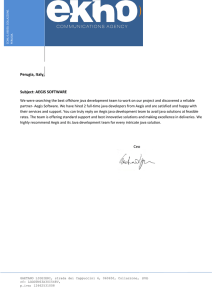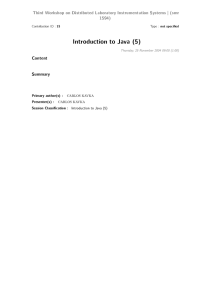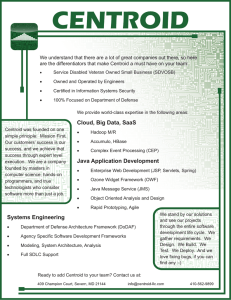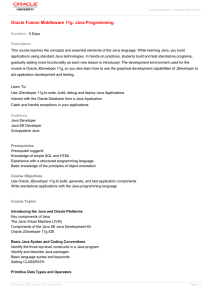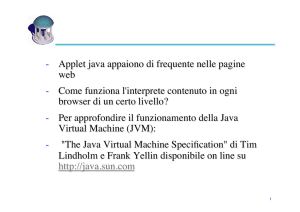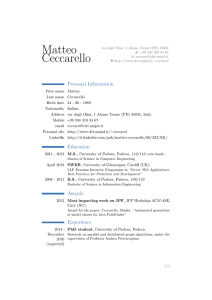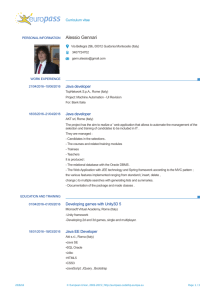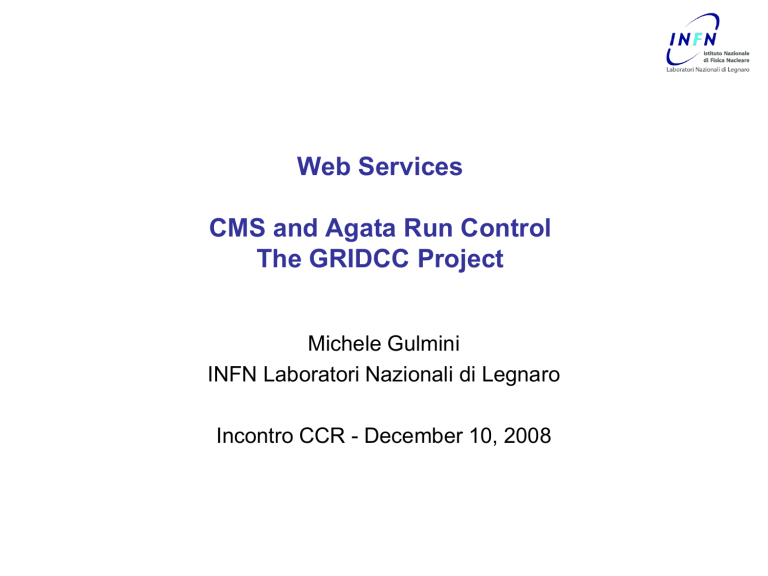
Web Services
CMS and Agata Run Control
The GRIDCC Project
Michele Gulmini
INFN Laboratori Nazionali di Legnaro
Incontro CCR - December 10, 2008
Contents
• The CMS Run Control and Monitor System
• Service Oriented Architecture
• Developing Web Services
• Server side experience
• The GRIDCC project
• The Agata Run Control
• Developing Web Services
• Client side experience
Incontro CCR - 10.12.2008
M.Gulmini
2
CMS
Total weight:
12500 T
Overall diameter: 15.0 m
Overall length: 21,5 m
Magnetic field: 4 Tesla
DAQ TDR Design
10.12.2008
Incontro CCR - 10.12.2008
M.Gulmini
3
Control and Monitor Requirements
Baseline DAQ
Configuration
• 512 inputs
• 2024 outputs
Control and Monitor
requirements
• O(104 ) distributed Objects
to
– control
– configure
– monitor
• On-line diagnostics
• Interactive system
Incontro CCR - 10.12.2008
M.Gulmini
4
Run Control and Monitor System
RCMS is integrated in the CMS On-line system :
• It controls the “DAQ component”
– Data transport
– Event processing
• It monitors the “Detector Control System” DCS
– manages the slow controls of the whole experiment.
The SOAP protocol and the Web
Services have been adopted as the
main means for communication .
The online process environment is XDAQ,
a C++ framework for a distributed Data
Acquisition System.
Incontro CCR - 10.12.2008
M.Gulmini
5
RCMS – Run Control and Monitor System
Service Oriented Architecture
• 1998: Java and CORBA (Common Request Broker
Architecture) as communication backbone
– Used in test-beams and DT chambers production centers
• 2001: HTTP + XML communication (JAXM)
– Tomcat application server
– Java applet GUI
• 2003: Adoption of SOAP as control communication backbone
– First RCMS official release (RCMS 1)
– “DAQKit” for CMS sub-detector DAQ teams
– Used in test-beams and production centers
• 2005: WSDL and Apache Axis
– RCMS 2
– JSP based GUI
– Sub-detector local DAQs, MTCC I&II (2006)
• Sept 2008: first LHC collision beam
– RCMS 3: Tomcat 5.5, Axis 1.4
Incontro CCR - 10.12.2008
M.Gulmini
6
RCMS Architecture
Top FM
Sub-Detector
Sub-Detector
Sub-Detector
Services
Services
Services
Sub-Detector
Function Manager
Sub-Detector
Sub-Detector
Event
Processor
FSM
Engine
Input
Handler
Resource
Proxy
Monitor Flow
Control Flow
State Flow
Error Flow
Customizable
DAQ (XDAQ)
Resources
Resources
Incontro CCR - 10.12.2008
M.Gulmini
7
Control Structure at MTCC I & II (2006)
User interaction with Web
Browser connected to Level 0
FM.
Web Browser (GUI)
TOP
Level 0 FM
LTC
RPC
CSC
Level 0 FM is entry point
to Run Control System.
ECAL
DT
DAQ
TRK
HCAL
Level 1 FM
FB
RB
FF
FEC
Level 2 FM
Level 2 FMs are subsystem specific custom
implementations.
Resources are online system
components
Resources
Incontro CCR - 10.12.2008
FED
Level 1 FM interface to
the Level 0 FM and
have to implement a
standard set of inputs
and states.
M.Gulmini
8
RCMS & Web Services – Why?
• TDR(2002):
– it is planned to maximise the use of standard software
technologies in the RCMS.
– Web technologies and in particular Web Services have been
chosen because they have been designed to interconnect highly
heterogeneous and distributed systems, therefore implying a rich
choice of available tools and solutions.
– Many of these widely-spread software tools follow an open-source
approach, thus facilitating the integration with other software
packages.
• Central DAQ provides tools to the sub-detector DAQ teams to
develop their own local DAQ and control systems (XDAQ and
RCMS).
• Adoption of XDAQ and RCMS (DAQKit) in the sub-detectors
makes the integration of the overall CMS DAQ easier.
• Adoption of web services standards (WSDL and SOAP) helps
sub-detector custom developments integration.
Incontro CCR - 10.12.2008
M.Gulmini
9
Web Services:
Server Side
Development
Incontro CCR - 10.12.2008
M.Gulmini
10
Web Services: the beginning
• WSDL Experience in CMS started in 2004
– Major revisit of all CMS DAQ software (XDAQ 3, RCMS2 …)
• Sun J2EE (Java 2 Enterprise Edition) tutorial is probably the
best way to start learning and working with Java Web Services
– Web Services are a sub-set of the J2EE specifications
• Apache Axis documentation is also quite good
• A (quick) investigation was done:
– Apache Tomcat / Axis 1.2
– Sun JWSDP 1.4 (Java Web Service Development Package)
• Uses Tomcat
– Sun Java System Application Server 8
• Interoperability tests:
– Web Service interface defined in Java
– WSDL generated from Java by using “Java2WSDL” tools (available
both for Sun and Axis)
Incontro CCR - 10.12.2008
M.Gulmini
11
Apache Axis & Sun JWSDP
• Web Application Life Cycle:
– 1. Develop the web component code.
– 2. Develop the web application deployment descriptor.
– 5. Deploy the application into a web container.
• 1) Java Code:
– (almost) 100% reusable
• If careful to use only “standard” (JAX-RPC) APIs
• Examples provided by Axis and Sun often use “custom” classes (API
implementations)
– javax.xml.rpc.* classes – OK
– org.apache.axis.* classes – NO (for code reuse)
• 2) Deployment descriptors:
– Custom (deploy.wsdd, sun-<module-type>.xml, …)
• 5) Web container installation, configuration, maintenance
– Custom
Full interoperability was demonstrated
Incontro CCR - 10.12.2008
M.Gulmini
12
Tomcat/Axis Java – The choice
• Had already experience with Apache Tomcat
– Open source and free to use
– already powering numerous large-scale, mission-critical web
applications
• The learning curve of a new Application Server in not deep
– Sun Application Server is quite complex
– JWSDP Reference Implementation was using Tomcat
• Axis has a very active user community and was already adopted
by many companies
– implements a sub-set of the J2EE functionalities
• Migration to another J2EE Application Server does not imply
java code changes
• Links: http://ws.apache.org/axis/ , http://tomcat.apache.org/
Incontro CCR - 10.12.2008
M.Gulmini
13
WSDL and Java Interface
• WSDL is complex
– It is not easy to write it by hand.
– It is more comfortable (easier and faster) to define the services API
in Java and then generate the WSDL (Java2WSDL tools)
• Java to WSDL mapping - Limitations
– “Behind the scenes, JAX-RPC maps types of the Java
programming language to XML/WSDL definitions. For example,
JAX-RPC maps the java.lang.String class to the xsd:string XML
data type. Application developers don’t need to know the details of
these mappings, but they should be aware that not every class in
the Java 2 Platform, Standard Edition (J2SE) can be used as a
method parameter or return type in JAX-RPC”.
– Supported types:
•
•
•
•
Incontro CCR - 10.12.2008
boolean, int, …
java.lang.Boolean, java.lang.Integer,…
Arrays: boolean[], int[], …
Java Beans
M.Gulmini
14
WSDL and Java Exceptions
• Exceptions (Axis documentation)
– This is an area which causes plenty of confusion, and indeed, the
author of this section is not entirely sure how everything works,
especially from an interop perspective.
– RemoteExceptions map to SOAP Faults
•
•
If the server method throws a java.rmi.RemoteException then this will be mapped into a SOAP
Fault. The faultcode of this will contain the classname of the fault. …If the recipient does not
know how to create an instance of the received fault, this mechanism does not work. …you can
only reliably throw java.rmi.RemoteException instances, rather than subclasses.
When an implementation in another language receives such an exception, it should see the
name of the class as the faultCode, but still be left to parse the body of the exception. You
need to experiment to find out what happens there.
– Exceptions are represented as wsdl:fault elements
•
•
•
Incontro CCR - 10.12.2008
If a method is marked as throwing an Exception that is not an instance or a subclass of
java.rmi.RemoteException…The exception is no longer a SOAP Fault, but described as a
wsdl:fault in the WSDL of the method. According to the JAX-RPC specification, your subclass of
Exception must have accessor methods …
If your exception meets this specification, then the WSDL describing the method will describe
the exception too, enabling callers to create stub implementations of the exception, regardless
of platform.
Again, to be sure of interoperability, you need to be experiment a bit. Remember, the
calling language may not have the notion of Exceptions, or at least not be as rigorous as
Java in the rules as to how exceptions must be handled.
M.Gulmini
15
Example: An RCMS Exception
• All RCMS service exceptions extend java.rmi.RemoteException
– Reduce interoperability problems
package rcms.fm.fw.service.command;
import java.io.Serializable;
import java.rmi.RemoteException;
/**
* Command Service Exception class.
*
*/
public class CommandServiceException extends RemoteException implements Serializable {
…
public CommandServiceException() {}
public CommandServiceException(String s) {…}
public CommandServiceException(String s, Throwable ex) {…}
public Throwable getException() {return exception;}
public void setException(Throwable exception) {…}
public String getMsg() {return msg;}
public void setMsg(String msg) {
this.msg = msg;
}
}
Incontro CCR - 10.12.2008
M.Gulmini
16
Development Environment
• Eclipse Integrated Development Environment (www.eclipse.org)
• Eclipse Plugins (http://www.eclipseplugincentral.com/ )
– Sysdeo Tomcat Launcher plugin
– Lomboz plugin (J2EE applications)
• Xdoclet to ease the deployment of the services
– http://xdoclet.sourceforge.net
– Mainly in the first phase we needed to change often the service API.
– Axis deployment descriptors automatically generated
• XDoclet is an open source code generation engine. It enables Attribute-Oriented
Programming for java. In short, this means that you can add more significance to
your code by adding meta data (attributes) to your java sources. This is done in
special JavaDoc tags.
Incontro CCR - 10.12.2008
M.Gulmini
17
Example: an Axis service
package rcms.fm.ws.command;
import javax.xml.rpc.ServiceException;
…
/**
* CommandService Web Service.
*
* @axis.service name="CommandService" scope="Application“ enable-remote-admin="true"
*
* @axis.bean name="CommandServiceException" package="rcms.fm.fw.service.command"
* @axis.bean name="StateMachineBean“ package="rcms.statemachine.definition.bean"
…
*/
public class FMCommand implements ServiceLifecycle,CommandServiceIF {
private CommandService commandService = null;
/**
* Synchronous commad execution….
*…
* @axis.method
* @param command the command to execute
* @param uriPath the URI identifying a resource
* @return the state after command execution
* @throws CommandServiceException
*/
public StateBean execute(String[] uriPath, CommandBean command) throws
CommandServiceException {
…
}
…
}
Incontro CCR - 10.12.2008
M.Gulmini
18
Ant and XDoclet
<!--Build file for deploying and undeploying RCMS web services into axis and make stubs.
This file is only used by RCMS developers.-->
<project name="rcms-parameter-deploy" default="axis-deploy" basedir=".">
<property file="build.properties" />
…
<!-- Generate the axis deployment descriptor -->
<target name="axisdoclet">
<taskdef name="templatedoclet" classname="xdoclet.DocletTask"
classpathref="xdoclet.class.path" />
<templatedoclet destdir="${output}" verbose="1">
<template templateFile="${deploy.xdoclet.template}" destinationFile="${deploy.wsdd}">
<configParam name="Xmlencoding" value="utf-8" />
</template>
</templatedoclet>
</target>
<!-- Generate the axis undeployment descriptor -->
…
<!-- Deploy the services into axis engine -->
<target name="axis-deploy" depends="axisdoclet,axisdoclet-undeploy">
<taskdef resource="axis-tasks.properties" classpathref="axis.classpath" />
<axis-admin port="${target.port}" hostname="${target.server}" failonerror="true"
servletpath="${target.appname}/services/AdminService" debug="true" xmlfile="${output}${deploy.wsdd}" />
</target>
<!-- Undeploy the services into axis -->
…
<!-- Generate the stubs -->
…
</project>
Incontro CCR - 10.12.2008
M.Gulmini
19
Example: Axis deployment descriptors
<?xml version="1.0" encoding="utf-8"?>
<deployment xmlns=http://xml.apache.org/axis/wsdd/ xmlns:java=http://xml.apache.org/axis/wsdd/providers/java
xmlns:xsi="http://www.w3.org/2000/10/XMLSchema-instance">
<service name="CommandService“ provider="java:RPC">
<parameter name="className" value="rcms.fm.ws.command.FMCommand" />
<!-- check if remoteAdmin param is present -->
<parameter name="enableRemoteAdmin" value="true" />
<parameter name="allowedMethods"
value="execute getState getUpdatedState getStateTree getUpdatedStateTree
getStateMachine getStateList "/>
<parameter name="scope" value="Application"/>
<beanMapping qname="ns:CommandServiceException" (Axis documentation)
xmlns:ns="urn:FMCommand"
languageSpecificType="java:rcms.fm.fw.service.command.CommandServiceException"
/>
<beanMapping qname="ns:StateMachineBean"
xmlns:ns="urn:FMCommand"
languageSpecificType="java:rcms.statemachine.definition.bean.StateMachineBean"
/>
…
</service>
</deployment>
<?xml version="1.0" encoding="utf-8"?>
<undeployment xmlns=http://xml.apache.org/axis/wsdd/ xmlns:java=http://xml.apache.org/axis/wsdd/providers/java
xmlns:xsi="http://www.w3.org/2000/10/XMLSchema-instance">
<service name="CommandService">
</service>
</undeployment>
Incontro CCR - 10.12.2008
M.Gulmini
20
The GRIDCC Project
http://www.gridcc.org
Incontro CCR - 10.12.2008
M.Gulmini
21
RCMS and GRIDCC
The Grid enabled Remote Instrumentation with Distributed Control and
Computation (GRIDCC) is a project funded by the European
community, aimed to provide access to and control of distributed
complex instrumentation.
•
It is a 3-years project started in September 2004
The RCMS software is the core of the
Instrument Element of the GRIDCC.
The RCMS software was developed in
closed collaboration with the GRIDCC.
CMS is one of the main applications for the GRIDCC project .
Incontro CCR - 10.12.2008
M.Gulmini
22
Instrument Element (IE): the basic idea
Instrument
Instrument
Instrument
Element
Element
Element
Virtual
Virtual
Control
Control
RoomRoom
Computing
Computing
Computing
Element
Element
Element
Storage
Storage
Storage
Elements
Elements
Element
Web Service
Interface
Existing
Grid Infrastructures
Execution
Service
Incontro CCR - 10.12.2008
M.Gulmini
23
(Some) GRIDCC Developments
• Virtual Control Room (VCR)
• Instrument Element web service façade
– WS-I compliance
•
•
•
•
•
•
•
Instrument Reservation (Web) Service
Problem Solver (Web) Service
Integration with GRID (EGEE) components
IE Security
Quality of Service
Automatic discovery of GRIDCC components (P2P approach)
Grid on a CHIP
– light version of IE to facilitate its adoption in the embedded
systems, including the FPGA based – Axis standalone
• Tiny IE : light version of IE
– Easier software deployment and installation
• JMS (Java Messaging System) experience
– When the web services performance is not enough…
– RMM – JMS (GRIDCC IBM)
Incontro CCR - 10.12.2008
M.Gulmini
24
Final Release: Instrument Element
SRM/GRIDFTP
Instrument
Element
GRID Access
Instrumentation Contorl
WS-I Compliant
GSI Security
Kerberos Security
Web Service
DB Store
File Store
Secure
BDII
Custom
RMM-JMS
GlueSchema extension
Store
Instrument Reservation
Discovery
Custom (JMS, ..... )
Service (IRS)
Data/Info
Pubblishing I’m
here
SRM-2.2
StoRM
BestMan
GSI Security
Instruments Access
Instrument Quality of Service(IQS) Custom
Incontro CCR - 10.12.2008
M.Gulmini
25
Web Services Performance
Service Invocation with 100 Input Tags
Server
Clients
Client/Server communications type:
Invocation per Second
1600
1400
1200
Servlet
1000
Servlet RPC
800
Servlet RPCXML
600
Web Services
400
200
• Simple HTTP
• SOAP + XML over HTTP
• Web Service
0
1
3
5
7
9
11
13
15
Number of Clients
The hardware and Software:
•Application Server: Dual Xeon1.8 GHz, with 1.5 GB RAM, Ethernet 1
Gbps
Red Hat Linux Advanced Server 2.1. Tomcat 5.0.28 Axis
•Clients: 15 Pentium III 600 MHz, with 256 MB RAM, Ethernet 1 Gbps
Linux Red Hat 7.0. java 1.4 application
Incontro CCR - 10.12.2008
M.Gulmini
26
When the WS performance is not enough…
• CMS DAQ Monitoring has been implemented in XDAQ (C++)
– O(106) monitorables per second
– XML communication protocol (WS-Eventing standard) at the beginning
– Binary protocol now
• GRIDCC exploits JMS (Java Message System)
– RMM – JMS (IBM GRIDCC)
Incontro CCR - 10.12.2008
M.Gulmini
27
The Agata Experiment
http://www-win.gsi.de/agata/
Incontro CCR - 10.12.2008
M.Gulmini
28
Agata Project
• The aim of Agata project is to develop, build and employ an Advanced
GAmma Tracking Array, AGATA, for nuclear spectroscopy.
• AGATA is being realized within a European collaboration and is
intended to be employed in experimental campaigns at radioactive and
stable beam facilities in Europe.
– First campaign: Legnaro
– Installation at LNL in
progress
– First data taking test next
week
Incontro CCR - 10.12.2008
M.Gulmini
29
Agata DAQ
Front-end electronic
and pre-processing
Slow Control
Pulse Shape Analysis
Histogrammer
Run Control and
Monitor
System
Event Builder
Tracking
The collaboration:
• Orsay (main data flow)
• Daresbury (slow control)
• Cracov (GUIs)
• Legnaro (Run Control)
Incontro CCR - 10.12.2008
On-line
Data analysis
Storage
M.Gulmini
30
Agata DAQ & Run Control
• The DAQ is developed in Ada programming language
– Narval ( http://narval.in2p3.fr/ )
• Orsay team (IN2P3)
• LNL is developing the “Run Control”
• GRIDCC Instrument Element software is used
– No major server side developments so far
• Porting to Java 6 and Tomcat 6
– Concentrate on “custom” control and monitor
• Wish (To Do) list
– Use Modern Web Services standards and tools
• JAX-WS APIs
• JAXB binding
• Axis 2
Incontro CCR - 10.12.2008
M.Gulmini
31
Agata Run Control Structure
GUI
WSDL Facade
Run Control Services
Run Control
Top Manager
Logging
Service
Resource
Service
Narval
Manager
DAQ
Narval
Incontro CCR - 10.12.2008
Ancillary
Ancillary
Manager
Manager
Prisma
DAQ
Slow
Slow
Manager
Manager
Slow
Slow
Control
Control
M.Gulmini
Storage
Manager
Disk
Manager
Grid
Manager
Grid
Data Mover
32
Web Services
Client side Development
Incontro CCR - 10.12.2008
M.Gulmini
33
WSDL: Axis Java client (I)
• RCMS, GRIDCC and Agata web applications use Axis stubs
– They communicate with other Java Axis Web Services
– For instance CMS Function Managers (FMs) retrieve the
configuration from the Resource Service WS, send commands to
other FMs, receive state change notifications from other FMs
• Agata DAQ is developed in Narval (Ada programming language)
– Narval distributed system provides a WSDL for control and
monitoring purposes (Generated by Ada2WSDL)
– Axis Java stubs were generated
• no particular problems
<?xml version="1.0" encoding="UTF-8"?>
<definitions name="narval_aws"
…
<!-- Generated by AWS/Ada2WSDL v1.1
on Wednesday 06 February 2008 at 10:05:01 -->
<types>…
</types>…
<message name="Send_Command_With_Arguments_Request">
<part name="Command" type="xsd:string"/>
<part name="Arguments" type="n1:String_Array"/>
</message>
<message name="Send_Command_With_Arguments_Response">
<part name="Result" type="xsd:string"/>
</message>
…
Incontro CCR - 10.12.2008
M.Gulmini
34
WSDL: Axis Java client (II)
• Agata: Slow Control WSDL (Daresbury)
– Defined in C language
• int Do-Reset (int *rc);
int Do-SetUp (int *rc);
int Do-Stop (int *rc);
int Do-Go (int *rc);
…
– WSDL generated using gSOAP
– WSDL implemented in Tcl for “digitizer electronics” (Daresbury)
• Tcl Web Server : http://www.tcl.tk/software/tclhttpd/
– WSDL implemented in Ada (ENX) for “segment and core
mezzanines” ( http://enx.in2p3.fr/ )
• Run Control Java/Axis stubs generated (Legnaro)
– First tests: no problems encountered
<?xml version="1.0" encoding="UTF-8"?>
<definitions name="DataAcquisitionControlServer“ targetNamespace="http://npg.dl.ac.uk:8015/DataAcquisitionControl.wsdl"
<message name="Get-StateRequest">
</message>
<message name="Get-StateResponse">
<part name="ResponseCode" type="xsd:int"/>
<part name="Code" type="xsd:int"/>
<part name="State" type="xsd:string"/>
<part name="Reason" type="xsd:string"/>
</message>
…
Incontro CCR - 10.12.2008
M.Gulmini
35
WSDL: XDAQ Client (CMS)
• CMS XDAQ C++ framework does not provide WSDL support
• But it fully supports SOAP (Xoap library)
• Communication with RCMS web services is achieved by
libraries that construct the proper SOAP messages
– Used Mainly for asynchronous notifications (state changes, errors)
• When stub generation from the WSDL is not available
– SOAP messages can/must be constructed by hand
– It works fine
– Complexity depends on WSDL complexity
In the class constructor:
rcmsStateNotifier_( logger_,getApplicationDescriptor(),getApplicationContext() )
Then:
try
{
rcmsStateNotifier_.stateChanged( "Error", xcept::stdformat_exception_history( exception ) );
}
catch( xcept::Exception &e )
{
LOG4CPLUS_ERROR( logger_, "Failed to notify state change: "
<< xcept::stdformat_exception_history(e) );
}
Incontro CCR - 10.12.2008
M.Gulmini
36
WSDL: Perl Client
• WSDL and SOAP support in Perl is provided by SOAP::Lite
package
• Collection of Perl modules which provides a simple and lightweight
interface to the Simple Object Access Protocol
• CERN Linux SLC 3.0.4 packages:
– perl-MIME-Lite (3.01-1), perl-MailTools (1.62-1), perl-SOAP-Lite
(0.55-3), perl-TimeDate (2.22-1)
– DII (Dynamic Invocation Interface) approach
• Widely Used in CMS
• Scripts to stress the control system
• Reproduce bugs
• Performance measurements
• Also used inside Labview for Mac (see later)
Incontro CCR - 10.12.2008
M.Gulmini
37
Perl Script : example
#!/usr/bin/perl
# getStateFM.pl
# Author: Andrea Petrucci
# date: 23/10/2005
use strict;
use SOAP::Lite;
my $WSDLCommandService="http://pccms143.cern.ch:8080/rcms/services/CommandService?wsdl";
my $NSCommandService = "urn:FMCommand";
my $HOSTCommandService = "http://pccms143.cern.ch:8080/rcms/services/CommandService";
my $CommandService = SOAP::Lite
->readable(1)
->xmlschema('http://www.w3.org/2001/XMLSchema')
->on_action( sub { return '""';} )
->proxy($HOSTCommandService)
->uri($NSCommandService);
my $method = SOAP::Data->name('getState')
->prefix('ns1')
->uri($NSCommandService);
my $result = $CommandService->call($method => ($uri));
if ($result->fault){
print join ';',
$result->faultcode,
$result->faultstring;
}else {
my $stateBean = $result->valueof('//getStateResponse/getStateReturn');
print "$stateBean->{'stateString'}\n";
}
Incontro CCR - 10.12.2008
M.Gulmini
38
WSDL Clients: GUIs for Run Control
Clients
Two basic ways:
• web service compliant clients
• browser via a JSP GUI
Server
IMS
JSP GUI
( RCMS Framework)
C ++
Function
Manager
Perl
Visual Basic
. NET
Java
SOAP/HTTP
Resource
Service
Visual C++
Web Service
Portal
Incontro CCR - 10.12.2008
M.Gulmini
39
JSP CMS Run Control GUIs
1) RCMS GUI
2) Function Manager Level Zero GUI
3) FED and TTS GUI
• JSP (Java Server Pages)
– Server side code generating HTML pages
– Use Java/Axis stubs
– Javascript and AJAX technology
Incontro CCR - 10.12.2008
M.Gulmini
40
Java Applet GUI example
• CMS test beams and production centers
Incontro CCR - 10.12.2008
M.Gulmini
41
LabView GUI
• WSDL client tests both with Mac and Windows
•
•
Incontro CCR - 10.12.2008
Windows: .NET support (OK)
• Some troubles with complex data structures
Mac: (KO)
• Perl scripting language as a workaround
M.Gulmini
42
GRIDCC VCR – Portal and Portlet
Incontro CCR - 10.12.2008
M.Gulmini
43
Agata GUI (Cracov)
• Prototype available, Developed in C++, Qt based
• Communicates to the Agata Run Control through the GRIDCC
WSDL facade
• Agata Week November 2007:
– “Lucky the WSDL files given to me are fully compatibile with my
gSOAP standard” (Jurek Grebosz)
Incontro CCR - 10.12.2008
M.Gulmini
44
Considerations
• Web Services are a wonderful paradigm for…
– Interoperation of software running on different platforms and
developed with different programming languages
– Quick development of clients
• Allow to concentrate on the business part of the application
• Many many useful “Web Services tools” available
• Suitable for “online” systems when performance is not a big
issue
– Run Control systems
Incontro CCR - 10.12.2008
M.Gulmini
45
Questions
?
Incontro CCR - 10.12.2008
M.Gulmini
46
People
• List of people working on the contents of this presentation (not
exhaustive, not ordered):
–
–
–
–
–
–
–
–
–
–
Incontro CCR - 10.12.2008
Michele Gulmini
Gaetano Maron
Pietro Molini
Andrea Petrucci
Alexander Oh
Francesco Lelli
Eric Frizziero
Sergio Traldi
Luigi Zangrando
Silvano Squizzato
M.Gulmini
47
SPARE SLIDES
JAX-RPC
JAX-RPC provides an easy to develop programming model for development of SOAP based
Web services.
The figure elaborates the normal Web service invocation architecture for the synchronous
request-response mode :
• The client uses runtime libraries to serialize Java objects to a SOAP message and sends it
to the Web service end point, using HTTP transport.
• As the Web service side that is deployed on Apache Tomcat receives this request, the
service-side JAX-RPC runtime deserializes the SOAP message in to Java types and
invokes the method on the Web service and in turn makes a call to Application 2.
• The Web service, after processing the request, sends response back to the client in a
similar.
10.12.2008
M.Gulmini
49
References
•
•
•
Web service : Web Services Architecture (http://www.w3.org/TR/ws-arch/)
WSDL : Web Service Description Language (http://www.w3.org/TR/wsdl)
Basic Profile Version 1.0 (http://www.ws-i.org/Profiles/BasicProfile-1.0-2004-0416.html)
Apache Tomcat : The Apache Jakarta Tomcat 5 Servlet/JSP Container
(http://tomcat.apache.org/tomcat-5.0-doc/index.html)
Apache Axis : Axis User’s Guide (http://ws.apache.org/axis/java/user-guide.html)
•
J2ee : Java 2 Platform, Enterprise Edition (http://java.sun.com/j2ee/1.4/)
•
JAX-RPC : Java API for XML-Based RPC (http://java.sun.com/webservices/jaxrpc/index.jsp)
•
10.12.2008
M.Gulmini
50
The Grid Technologies to extend the limit of a
single computer (center)
Storage
Element
Computing
Element
Grid Gateway
Grid
Technolo
gies
Computing
Element
User Interface
Computing
Element
10.12.2008
M.Gulmini
51
Extending the Grid Concepts
Grid Gateway
Satellite views
to monitor the volcano
Grid
Technolo
gies
Terrestrial probes to monitor
The volcano activities
To model calculations
Control and Monitor Room and disaster predictio
10.12.2008
RCMS Services
– SECURITY SERVICE
• login and user account
management;
– RESOURCE SERVICE (RS)
• information about DAQ
resources and partitions;
– INFORMATION AND MONITOR
SERVICE (IMS)
• Collects messages and monitor
data; distributes them to the
subscribers;
– JOB CONTROL
• Starts, monitors and stops the
software elements of RCMS,
including the DAQ components;
53
10.12.2008
M.Gulmini
The GRIDCC Architecture
Instruments Grid
Computational Grid
CE
CE
WMS
SE
Instrument
Element
Virtual
Control
Room
Cooperative Environment
Workflow Mng System
Execution
Agreement Service
Service
F. Lelli, 3rd (final) GRIDCC Annual Review, London, 15 October 2006
10.12.2008
M.Gulmini
54
First collision beam configuration. Sept 08
Incontro CCR - 10.12.2008
M.Gulmini
55
Instrument Element Requirements
Web Services
Storage
Element
Computing
Element
Instrument Element
Grid
Any Protocol or
physical connection
Sensor
Instrument
Network
Instrument
Computing
Element
W
E
A
C
B
Incontro CCR - 10.12.2008
D
F
Instrument
Element
1: Provide a uniform access to
the physical devices
2: Allow a standard grid access
to the instruments
3: Allow the cooperation
between different instruments
that belong to different VOs
M.Gulmini
56
GRIDCC – IE technologies
•
Web Service compliant (WS-I)
•
Tomcat + Axis (and Java) and Axis standalone are the main technologies of
the IE
•
All the services are deployed on a single or multiple instances of Tomcat,
according to the needs of the application
•
Message oriented middleware (Pub/Sub) is based on the Java Messaging
System (JMS). The following implementations are used in the project
–
RMM - JMS (GridCC IBM)
•
MySQL and Oracle are used as Data Base for the RS
•
STORM vers. 1.2 is the used SE that exposes a SRM interface version 2.2
10.12.2008
M.Gulmini
57


